RMS
Conservation and Cleanup Efforts of Auburn Staff Win Government Partner Award
5/1/2023

The conservation and volunteer efforts of Auburn University employees continue to earn major recognition.
The Help the Hooch Cleanup was chosen by Rivers Alive as the 2022 Government Partner Award winner. The award was presented to the Ft. Benning Department of Public Works (DPW) Environmental Programs and Auburn University Intergovernmental Service Agreement (IGSA) Clean Water Team at the Rivers Alive awards ceremony and luncheon on Thursday, April 27th in Atlanta. Team Members Erin Perry (NPDES Compliance Technician), Jasmine Truitt (NPDES Compliance Specialist), Anthony Harrington (GIS Specialist), and Jack Hovey (NPDES Compliance Specialist), were recognized (Pictured Above L-R).
The Help the Hooch event was held on October 14, 2022, and began at the Uchee Creek Marina. The cleanup event was open to soldiers, families, and partner organizations and helped to remove an estimated 130 bags of trash, 31 tires, and about 500 pounds of metal. The most common items included plastic bottles, aluminum cans, and fishing supplies.
The Help the Hooch is an integral conservation event to help maintain a key portion of the Chattahoochee River. The river is home to over 20 species of freshwater turtles, nine threatened and endangered species, and one of only two trout streams that flow through a major urban area.
Auburn University faculty, staff, and students are encouraged to participate in the 2023 Help the Hooch cleanup event. Information about the 2023 event including registration information and dates will be advertised on campus and AU News.
Parkerson Mill Creek Litter and Invasive Plant Removal
11/17/2022
Auburn University Risk Management & Safety (RMS), the Department of Crop, Soils, and Environmental Sciences, the AAES Water Resources Center, and the city/municipal governments of Auburn, Opelika, Lee County, and Smiths Station, will host a creek clean-up event on Wednesday, November 30th, from 2:00 pm until 4:00 pm along the banks of the campus’ Parkerson Mill Creek. Students, faculty, staff, and those associated with the university community are invited to participate in the event.
A small stream that stretches past the football and baseball fields and the old coliseum on the campus, the Auburn University Parkerson Mill Creek was transformed in 2014 into an area used as outdoor classrooms for environmental research. It is up to the Auburn University community to keep this living stream vibrant, clean, and beautiful.
Volunteers for the event should meet beside the Auburn Wellness Kitchen, at 1:30 pm. Gloves and bags will be available for collecting, but participants will be responsible for bringing appropriate footwear, such as rubber boots or waders. Participants will need to sign a Volunteer Release & Acknowledgement of Risk waiver prior to collecting; forms will be available on the day of the event.
Register Today at aub.ie/creekcleanup
For more information or to request a waiver, please contact Tom McCauley at mccautp@auburn.edu
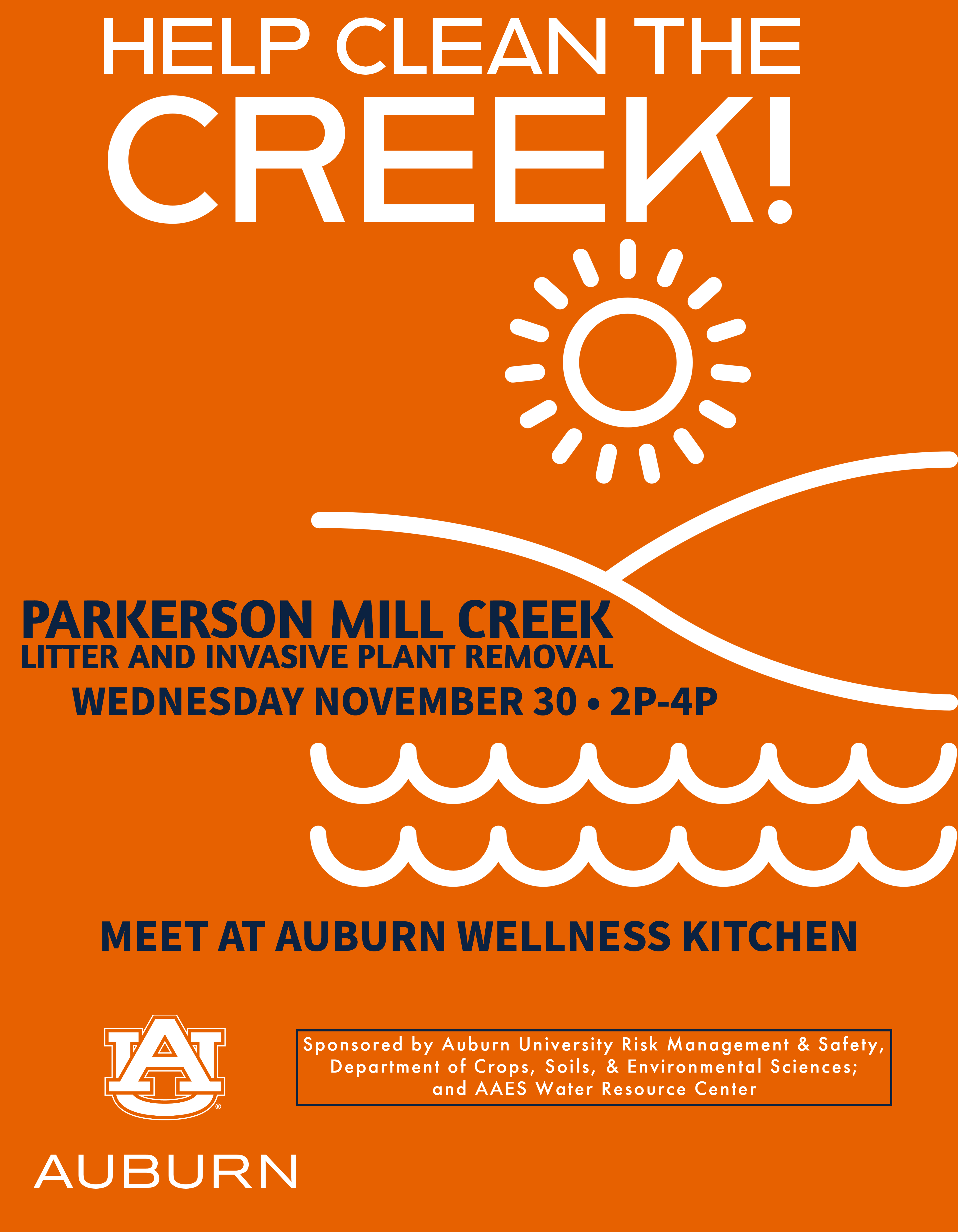
Help the Hooch
9/29/2022
Auburn faculty, staff, and students are encouraged to “Help the Hooch” at Fort Benning on October 14th from 7:30 am until 11 am Central Time. Fort Benning is hosting their annual Chattahoochee River Cleanup event and by donating your time, you will directly improve the water quality of the communities and recreation areas downstream of Fort Benning.
If you’ve spent time in or on the water, enjoy fishing in Lake Eufaula, or even spend time in the Gulf of Mexico, then you’ve benefited from the amazing natural resource that is the Chattahoochee River. Keeping this integral watershed healthy is vital to the Auburn community.
Participants are asked to meet at Pavilion 1 at Uchee Creek Marina and will be removing solid waste and trash from the waterway by boat and by land. You are also welcomed to bring your own boat.
A free pizza lunch, t-shirt, and cleanup supplies will be provided to volunteers.
To register visit
https://sites.google.com/view/2022-help-the-hooch/home or call 706-545-3604 for any questions.
Fire Safety Festival
9/8/2022
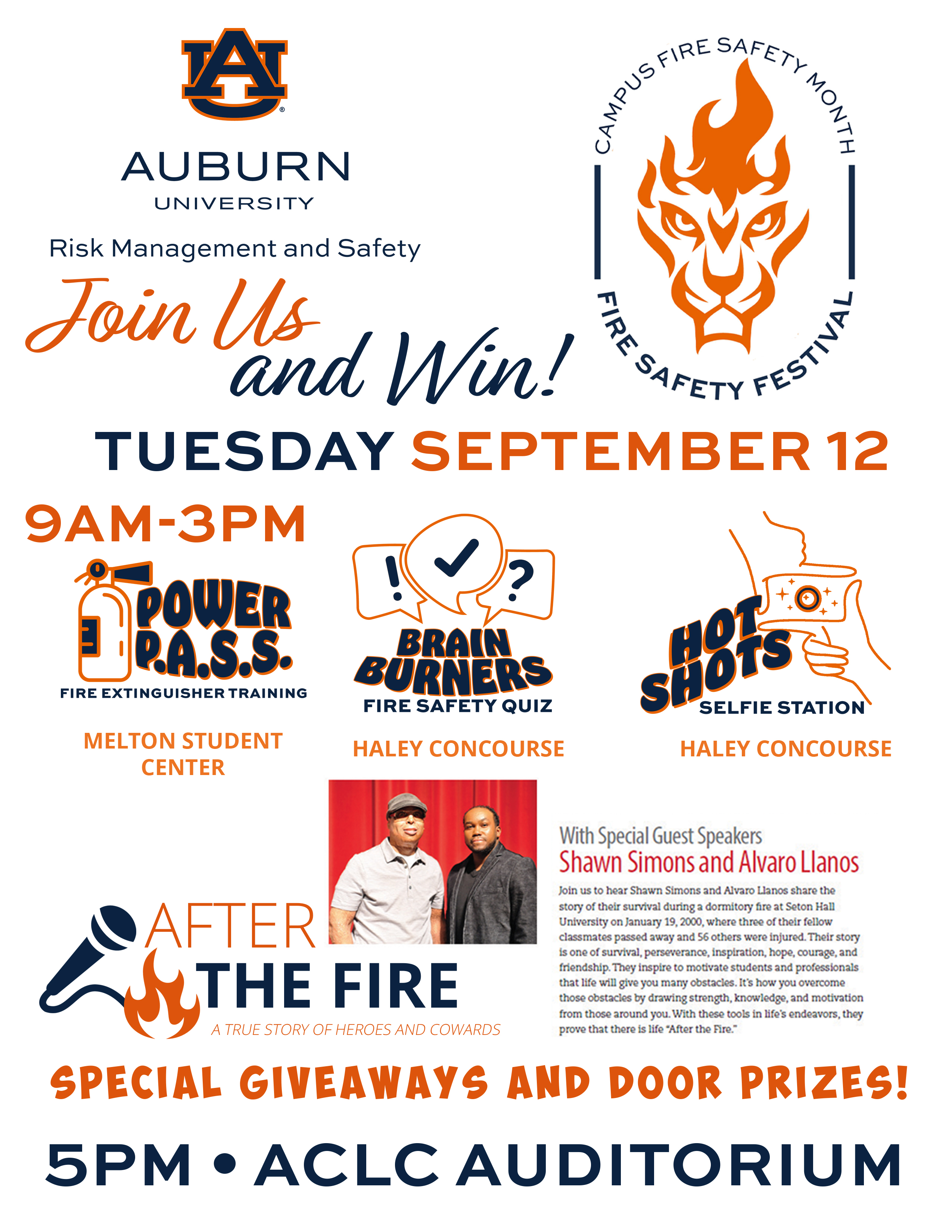
September is Campus Fire Safety Month and Auburn University is gearing up for the first ever FIRE SAFETY FESTIVAL on Wednesday September 14th from 10 am until 2pm. RMS team members and volunteers will be set up around campus with games, giveaways, and prizes.
The Brain Burners Fire Safety Quiz will be on the Haley Concourse. Participants will be asked three questions related to fire safety. Get them right and spin the wheel to win a prize!
The Hot Shots Selfie Station will be set up at the Edge at Central Dining. It’s easy to participate. Just snap a selfie and post it on social media or send it to a friend. Once you do, you win!
The Power P.A.S.S. station will be set up in the Melton Student Center. Get firsthand experience fighting fires with our state-of-the-art extinguisher simulator. Once you learn to P.A.S.S. then you’re all set and you win!
Punch-cards will be available at each station. Participants who visit all three stations on September 14th can be entered to win a number of amazing grand prizes.
Learning more about Fire Safety has never been easier or fun!
For questions or additional information, please contact Kevin Ives at pki0002@auburn.edu
Risk Management and Safety Announces Winter Holiday Waste Service Protocol
11/29/2021
Both chemical and medical waste pickups will be temporarily suspended throughout the Auburn University recognized holiday period. Any chemical and/or medical waste generated during the holiday break should be properly containerized, labeled, and stored per guidelines found on the RMS/EHS webpage www.auburn.edu/administration/rms/environmental.html .
Chemical and medical waste pickups will resume on January 3, 2022, on an as-requested basis.
Pathological waste pickup service will be provided throughout the holiday period on an as-needed and as-requested basis. Pickup requests shall be submitted through the AiM work management system (https://aim.auburn.edu/aim ).
Advance notice shall be coordinated with primary contact Steven Nolen (334-703-3859) or secondary contact Billy Cannon (334-703-0419), to ensure the timely removal of pathological waste from your areas during this period.
If you anticipate your areas needing servicing over the observed holiday break, please contact me Tom McCauley, Environmental Health & Safety Program Manager at 334-844-4870 so that RMS may coordinate in advance as best we can to accommodate your needs.
RMS Safety and Health Specialist Donna Tucker wins big at PHBA World Championship
7/26/2021

Congratulations to Risk Management and Safety’s Donna Tucker for multiple wins at the Palomino Horse Breeders of America (PHBA) World Championship Show.
The PHBA World Championship Show was held July 5th through 15th at the Illinois State Fairgrounds in Springfield, Illinois.
Tucker and “Sudden Winds” were named an Amateur Select Golden Horse. They were also selected as High Point Ranch Horse Winners in both Amateur and Amateur Select. Additionally, Tucker also captured first place in the Amateur Team Tournament.
Photo via Jeff Kirkbride Photography (http://jeffkirkbridephoto.photostockplus.com/albums/)
Auburn Risk Management and Safety Featured on URMIA Matters Podcast
7/7/2021
The University Risk Management and Insurance Association (URMIA) recently featured Auburn University and Risk Analyst Evan Ferguson on their URMIA Matters podcast. The podcast discussed the Student Property Insurance Program (SPIP). Evan detailed how the program has helped Auburn University Risk Management and Safety better serve the University and how the program benefits Auburn student faculty and staff. You can listen here: https://urmiamatters.buzzsprout.com/687161/8757933-problem-solved-urmia-student-property-insurance-program
The SPIP program, which is available to all Auburn University students, faculty, and staff, helps to better protect and insure some of the items we use everyday while on campus.
Frequent cases of property loss include theft and accidental damage (dropping, spilling liquids, and similar events). If this were to happen, your out-of-pocket costs to repair or replace will generally run between $500 and $2,000.
Although some homeowners policies provide some coverage, they generally do not cover “breakage” or accidental damage, and usually have high deductibles that effectively leave most property losses unrecoverable. For these reasons, it is strongly encouraged to have a personal property insurance policy for their belongings while living and working on campus. You can learn more about the SPIP at Auburn here: https://cws.auburn.edu/rms/pm/rentersinsurance
Combating Fatigue during COVID-19
6/17/2020
The drowsiness, distraction and lack of alertness that is associated with fatigue can have devastating effects for both workers and organizations in terms of injuries and fatalities. A National Safety Council survey (2018) found that nearly all American workers (97%) have at least one risk factor of fatigue, with 43% of workers not obtaining the recommended 7-9 hours of sleep a day. This reduces productivity and efficiency, and increases the risk of injury.
Organizations in safety-critical industries also have higher risk because the impact of fatigue is more than just lower productivity. Increased health care costs, lawsuits, breach-of-contract issues and lost business are just a few of the significant financial costs of fatigue that organizations may experience. With these consequences in mind, we turn now to some helpful tips to addressing workplace fatigue in light of the current pandemic.
Planning for demanding (physically, mentally) and repetitive tasks
Regular breaks during a work shift allow for both physical and mental restoration. Short, frequent breaks (say, 10-15 minutes every two hours) are better than a single longer break mid- shift, providing employees a chance to clear their heads and feel refreshed when transitioning between tasks. A dedicated break room facility can enhance these benefits. Employers may consider staggering these shorter, more frequent breaks so that employees can maintain a healthy social distance.
Days off during the week
Policies should be established to allow for regular and predictable blocks of days off. Workers should be provided as much advance notice as possible of long blocks of work days so they can best plan for rest and sleep during their time off. During a pandemic, it’s expected that some workers, especially in healthcare, will be working extended shifts with fewer days off.
Compensatory rest periods after long blocks of work days, however, will allow workers to obtain recovery sleep and return to work with more energy and alertness.
Managing shift scheduling
Planned, consistent work schedules allow workers to better plan for sleep during their time between work periods, even if work is scheduled for early morning or overnight shifts. Limiting shift work is typically preferable, considering that our body clocks are naturally at a low energy point between midnight and 6:00 a.m. Carefully planning shift schedules during pandemic times can allow business operations to continue with fewer workers on site at a time.
Fatigue reporting systems
It’s recommended that any organization include a fatigue reporting system, such as in the transportation industry, to ensure that workers in safety critical jobs are fit for duty. Another good measure is to include fatigue as an element in incident reporting so that risk factors (e.g. time of day, type of task) can be recorded and tracked. Under pandemic conditions, it’s expected that fatigue risk will increase. Having fatigue reporting systems in place can help organizations monitor and control risk even when conditions return to “normal.”
For more information on how to manage workplace fatigue, please visit nsc.org/fatigue. And for the latest information on managing workplace safety during the coronavirus pandemic, please visit nsc.org/coronavirus .

Fire Alarm Emergency Notification Test
5/4/2020
Campus Safety & Security will be conducting testing of the fire alarm emergency notification system in 60 buildings on campus after 3:00 p.m. on Tuesday, May 5. The testing should take an hour or less.
During this time, horns will sound, strobes will flash, and a series of emergency messages will be broadcast throughout affected buildings.
If at any time during the testing you believe there is a real emergency, DIAL 911 immediately. If an actual emergency occurs, a live public address message will be broadcast to provide instructions to building occupants.
We appreciate your understanding and apologize for any inconvenience. If you have any questions, please email campussafety@auburn.edu.
Create Work From Home Success with Office Ergonomics Awareness
3/23/2020
To help aide in social distancing and alternate operations at Auburn University, many faculty, staff, and students are now working and studying at home. To help support success, Risk Management and Safety has developed a short Office Ergonomics Awareness Course. This course will help you recognize potential hazards and stressors that may impact your health, productivity, and ability. This course will also give you tips, tricks, and prevention strategies to help make working from home as comfortable, productive, and rewarding as possible. The Office Ergonomics Awareness Course is available by visiting https://aub.ie/ergonomics. For more information or questions, please email aurms@auburn.edu or call 334-844-4870.
Parkerson Mill Creek Cleanup
2/21/2020
Auburn University Risk Management & Safety (RMS), the City of Auburn, and Omega Phi Alpha will host a creek clean-up event on Sunday, February 23rd, from 1:00 pm until 3:00 pm along the banks of the campus’ Parkerson Mill Creek. Students, faculty, staff and those associated with the university community are invited to participate in the event.
A small stream that stretches past the football and baseball fields and the old coliseum on the campus, the Auburn University Parkerson Mill Creek was transformed in 2014 into an area used as outdoor classrooms for environmental research. It is up to the Auburn University community to keep this living stream vibrant, clean and beautiful.
Volunteers for the event should meet in front of the Wellness Kitchen in the Beard-Eaves Memorial Coliseum parking lot, next to the creek, at 1:00pm. Gloves and bags will be available for collecting, but participants will be responsible for bringing appropriate footwear, such as rubber boots or waders. Students will need to sign a Volunteer Release & Acknowledgement of Risk waiver prior to collecting; forms will be available the day of the event.
To register, please visit aub.ie/creek
For more information or to request a waiver, please contact Tom McCauley at mccautp@auburn.edu
Parkerson Mill Creek Cleanup
2/20/2020
Auburn University Risk Management & Safety (RMS), the City of Auburn, and Omega Phi Alpha will host a creek clean-up event on Sunday, February 23rd, from 1:00 pm until 3:00 pm along the banks of the campus’ Parkerson Mill Creek. Students, faculty, staff and those associated with the university community are invited to participate in the event.
A small stream that stretches past the football and baseball fields and the old coliseum on the campus, the Auburn University Parkerson Mill Creek was transformed in 2014 into an area used as outdoor classrooms for environmental research. It is up to the Auburn University community to keep this living stream vibrant, clean and beautiful.
Volunteers for the event should meet in front of the Wellness Kitchen in the Beard-Eaves Memorial Coliseum parking lot, next to the creek, at 1:00pm. Gloves and bags will be available for collecting, but participants will be responsible for bringing appropriate footwear, such as rubber boots or waders. Students will need to sign a Volunteer Release & Acknowledgement of Risk waiver prior to collecting; forms will be available the day of the event.
To register, please visit aub.ie/creek
For more information or to request a waiver, please contact Tom McCauley at mccautp@auburn.edu
Risk Management and Safety Encourages Recycling of Used Electronics
1/30/2020
Reduce, Reuse, Recycle – RMS encourages recycling of used electronics.
Many old electronic devices such as computer monitors, television, printers, etc; contain toxic and harmful elements including chromium, mercury, lead, and cadmium. Electronics also contain valuable raw materials and by recycling these items you can reduce impacts from mining and manufacturing.
For recycling of electronics owned by AU departments contact Surplus Property at 334-844-4984 to arrange drop-off of your electronics.
To find out where you can donate or recycle your personal electronic devices go to https://www.epa.gov/recycle/electronics-donation-and-recycling
Risk Management and Safety warns against use of Methylene Chloride Paint Remover
12/5/2019
On November 22, 2019, the Environmental Protection Agency (EPA) issued regulations on the consumer use of methylene chloride paint removers. The methylene chloride chemical was commonly found in many popular solvent-based strippers/removers due to the effectiveness. Paint removers containing methylene chloride could strip up to 15 layers in paint in as a little as 15 to 30 minutes.
It is now unlawful for any person or retailer to sell or distribute paint removal products containing methylene chloride. This includes e-commerce retailers such as Amazon or E-Bay. These EPA regulations prohibit the manufacture, import, processing, and distribution of these products. The EPA has taken action because of acute fatalities that have resulted from exposure to the chemical. Additional information on the risks associated with methylene chloride can be found here: https://www.epa.gov/assessing-and-managing-chemicals-under-tsca/risk-management-methylene-chloride .
Most retailers phased out the selling and distribution of affected products by the end of 2018. This includes Ace Hardware, Amazon, Walmart, Lowes, Home Depot, and Sherwin-Williams. However, many consumers may have purchased affected paint removers. Because of this, Auburn University Risk Management and Safety recommends reviewing any solvent-based paint removers/strippers you may have in your home or workspace. If you have any of these products, do not use them and ensure their containers are sealed and puncture free.
If you are in possession of any methylene chloride based solvents on campus, please contact Risk Management and Safety at 334-844-4870 or aurms@auburn.edu
If you are in possession of any methylene chloride based solvents in your home, please contact your city or community’s environmental services office.
Stay Fire Safe
9/18/2019
Join Auburn University Risk Management and Safety for "Stay Fire Safe", an interactive fire safety training presentation. This event will show how to use a fire extinguisher, cooking safety tips, pet fire safety tips, and more. Plus, as an added bonus there will be door prizes including an iPad, Auburn Tailgate Tent, Gift Cards, and more! Everyone who attends will get either a Risk Management and Safety Microwave Pinch Mitt or a Fire Extinguisher Stree Reliever. Join us in Haley Room 2370 from 6:30pm until 7:30pm on Wednesday September 25th
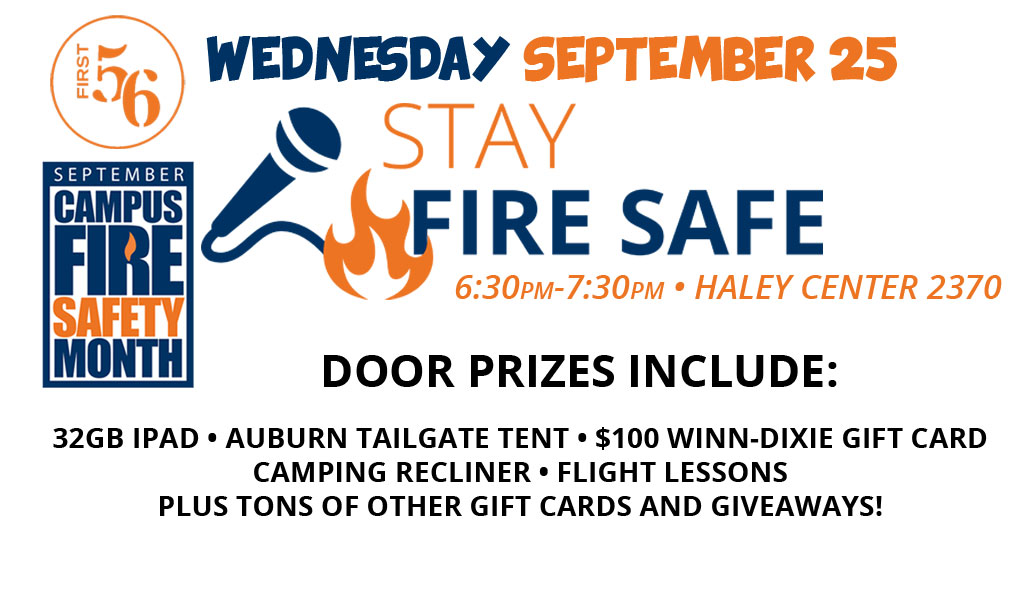
Laser Safety Awareness Day
9/9/2019
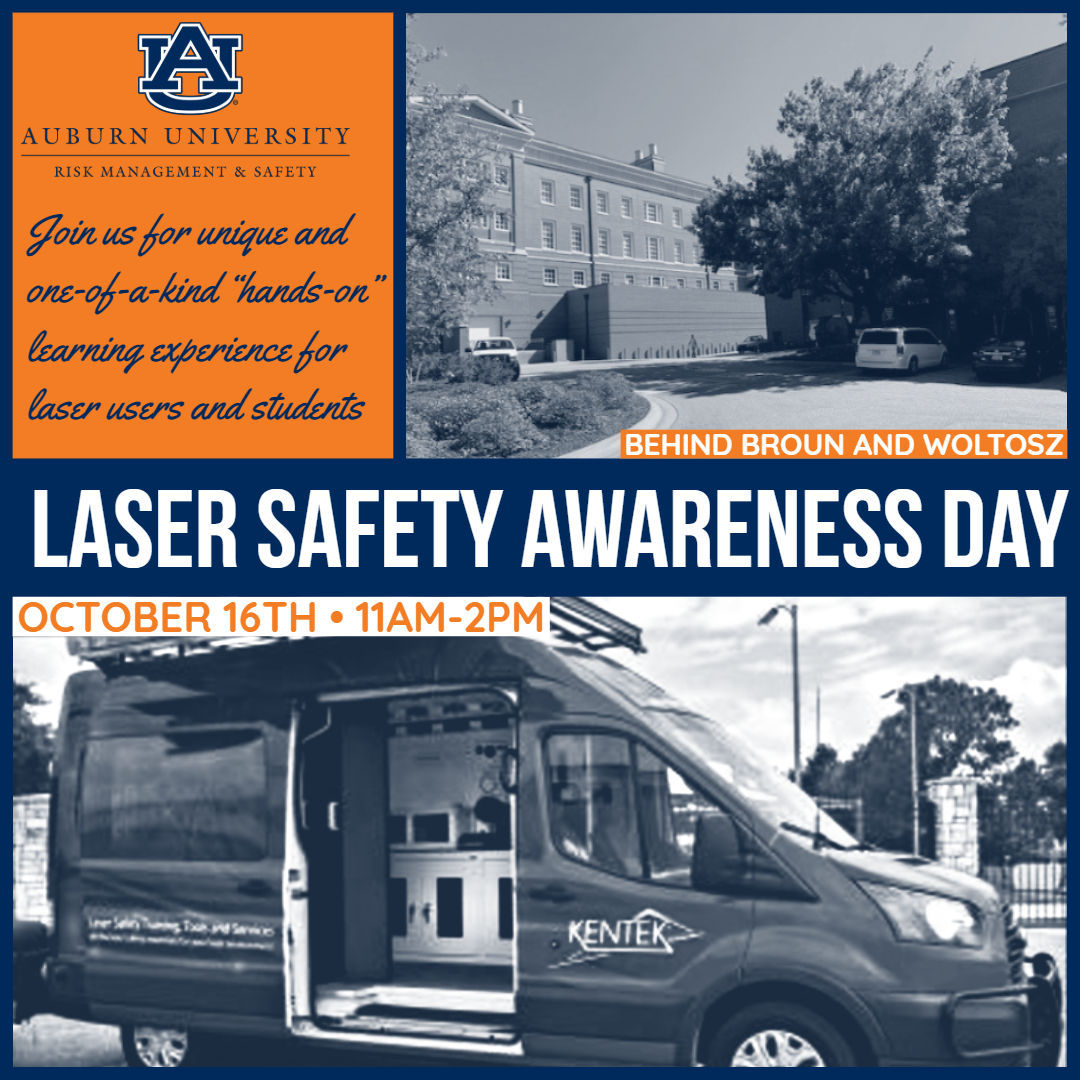
Auburn University Risk Management and Safety (RMS) Department will be hosting Campus Laser Safety Awareness Event on October 16th, 2019 from 11 am to 2 pm at the back parking lot of Broun Hall and Woltosz. Auburn University professors and their laser users are all invited. Through this campus event, we hope to build awareness around laser safety and provide an opportunity for laser users to deepen their understanding of laser safety as laser use and application diversifies on campus.
This year we will be hosting Kentek, one of the leading companies on laser safety products. Kentek will bring the company’s laser safety expertise and educational capabilities to AU campus. Kentek’s PHOTON1 van will be filled with an interactive display of all of laser safety products. Kentek Laser safety specialist will demonstrate their products and answer some questions. This will be a unique "hands-on" learning experience for AU laser users and students.
Please save the day on October 16th for 2019 for Campus Laser Safety Awareness Event and come join us to support the event and encourage your students to be part of this educational platform.
Recycling: It's a Team Effort
9/3/2019
The work of Risk Management and Safety was recently highlighted in a post on the Office of Sustainability's Blog:
Learn more about how RMS and the battery recycling program is making a difference on campus but reading the full artilce by Hollie Lee here.
Lab Safety Training
5/13/2019
.jpg)
Auburn University Risk Management and Safety will hold Lab Safety Training Sessions on Friday, May 17th in room 109 of the CASIC Building (570 Devall Drive). In order to accommodate as many participants as possible, these Lab Safety Training Sessions will be offered at two separate times: 10:00am and 3:00pm. Both sessions are scheduled to last 90 minutes.
The Lab Safety Training Sessions will cover basic lab safety, biological Safety and hazardous waste management.
Auburn University Risk Management and Safety encourages all visiting summer researchers who will be working in labs to attend either of the training sessions.
Auburn RMS and Auburn Global partner for unique Fire Safety Presentations
4/8/2019

Auburn University Risk Management and Safety (RMS) partnered with Auburn Global for a series of Fire Safety Demonstrations. Three separate sessions were held and were attended by close to 450 students. Safety and Health Specialist Jon Haney delivered a specially tailored message to promote fire safety in off-campus living spaces. This message included a hands-on demonstration of proper fire extinguisher use, video examples of the power of fire, and simple and effective tips for cooking safety.
This collaboration between Auburn Global and Auburn Risk Management and Safety to was specifically designed to serve Auburn’s International Student population and to target an area of need on campus. RMS is committed to find unique and specialized trainings and outreach efforts to better serve the entirety of Auburn University.
After the success of this event, RMS will incorporate more individual and specialized trainings during September’s Campus Fire Safety Month. If your group, organization, or office would like to arrange Fire Safety Training or partner with RMS during Campus Fire Safety Month then please contact Auburn Risk Management and Safety at aurms@auburn.edu
Volunteers Needed for Parkerson Mill Cleanup on February 23rd
2/15/2019
Auburn University Risk Management & Safety (RMS), the City of Auburn, Auburn University Crop, Soils, and Environmental Sciences Club, and the Alpha Epsilon Honor Society will host a creek clean-up event on Saturday, February 23rd, from 1:30 pm until 4:00 pm along the banks of the campus’ Parkerson Mill Creek. Students, faculty, staff and those associated with the university community are invited to participate in the event.
A small stream that stretches past the football and baseball fields and the old coliseum on the campus, the Auburn University Parkerson Mill Creek was transformed in 2014 into an area used as outdoor classrooms for environmental research. It is up to the Auburn University community to keep this living stream vibrant, clean and beautiful.
Volunteers for the event should meet behind the intramural fieldhouse, next to the parking lot, at 1:00pm. Gloves and bags will be available for collecting, but participants will be responsible for bringing appropriate footwear, such as rubber boots or waders. Students will need to sign a Volunteer Release & Acknowledgement of Risk waiver prior to collecting; forms will be available the day of the event.
To register, please visit aub.ie/creek
For more information or to request a waiver, please contact Tom McCauley at mccautp@auburn.edu or Dusty Kimbrow at dkimbrow@auburnalabama.org
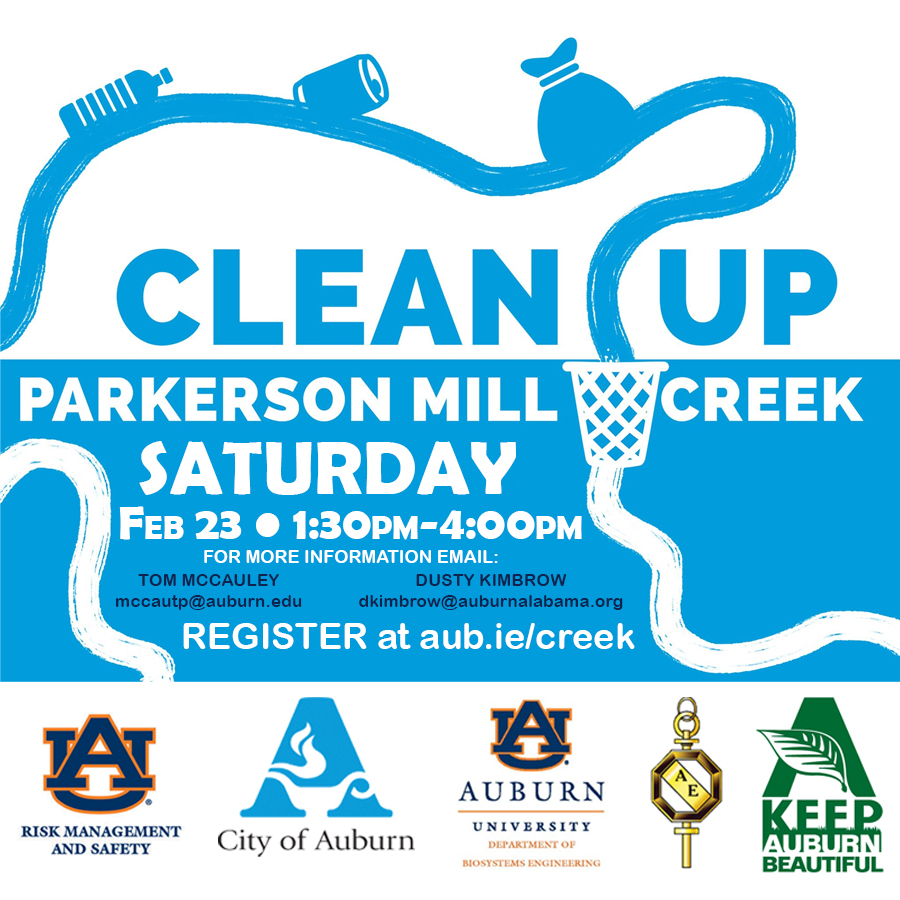
Parkerson Mill Cleanup
2/15/2019
Auburn University Risk Management & Safety (RMS), the City of Auburn, Auburn University Crop, Soils, and Environmental Sciences Club, and the Alpha Epsilon Honor Society will host a creek clean-up event on Saturday, February 23rd, from 1:30 pm until 4:00 pm along the banks of the campus’ Parkerson Mill Creek. Students, faculty, staff and those associated with the university community are invited to participate in the event.
A small stream that stretches past the football and baseball fields and the old coliseum on the campus, the Auburn University Parkerson Mill Creek was transformed in 2014 into an area used as outdoor classrooms for environmental research. It is up to the Auburn University community to keep this living stream vibrant, clean and beautiful.
Volunteers for the event should meet behind the intramural fieldhouse, next to the parking lot, at 1:00pm. Gloves and bags will be available for collecting, but participants will be responsible for bringing appropriate footwear, such as rubber boots or waders. Students will need to sign a Volunteer Release & Acknowledgement of Risk waiver prior to collecting; forms will be available the day of the event.
To register, please visit aub.ie/creek
For more information or to request a waiver, please contact Tom McCauley at mccautp@auburn.edu or Dusty Kimbrow at dkimbrow@auburnalabama.org

Parkerson Mill Creek Clean-up Event
11/20/2018
Auburn University Risk Management & Safety (RMS) and the City of Auburn will host a creek clean-up event on Tuesday, November 27, from 9 a.m. until Noon along the banks of the campus’ Parkerson Mill Creek. Students, faculty, staff and those associated with the university community are invited to participate in the event.
A small stream that stretches past the football and baseball fields and the old coliseum on the campus, the Auburn University Parkerson Mill Creek was transformed in 2014 into an area used as outdoor classrooms for environmental research. It is up to the Auburn University community to keep this living stream vibrant, clean and beautiful.
Volunteers for the event should meet behind the intramural fieldhouse, next to the parking lot, at 9 a.m. Gloves and bags will be available for collecting, but participants will be responsible for bringing appropriate footwear, such as rubber boots or waders. Students will need to sign a Volunteer Release & Acknowledgement of Risk waiver prior to collecting; forms will be available the day of the event.
For more information or to request a waiver, please contact Tom McCauley at mccautp@auburn.edu or Dusty Kimbrow at dkimbrow@auburnalabama.org
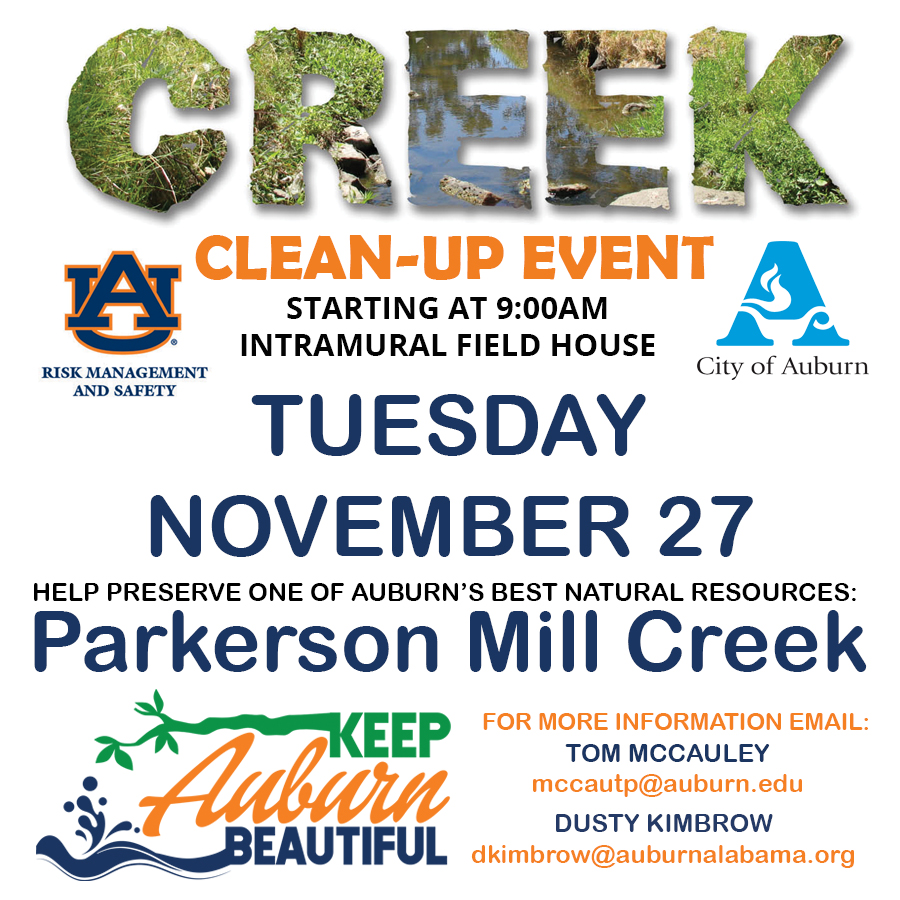
Campus Fire Safety Month 2018 is a success for RMS and Auburn
10/1/2018

With September ending, Auburn University Risk Management and Safety wrapped up another successful Campus Fire Safety Month. The month of September saw an increased push for fire awareness and campus readiness with activities, events, and signage throughout campus and the community.
The events kicked off with “Popcorn and Prevention”, where RMS Staff met students and handed out bags of microwave popcorn. The popcorn was labeled with cooking safety tips and was chosen because improperly cooked popcorn was one the leading cause of fire alarms going off. This simple example showed how even the smallest things should be noticed and remembered when it comes for fire safety.
RMS Staff members also brought a new activity to students, faculty, and staff: the FireSmarter Gameshow. The knowledge of basic fire safety tips was tested in a fun and interactive man-on-the-street game and after answering, students could spin the wheel for prizes and left a little fire smarter and fire safer.
Finally, Risk Management and Safety welcomed national renown speakers Sean Simons and Alvaro Llanos as they shared their personal and inspirational story of recovery, redemption, and hope after surviving a fatal campus fire at Seton Hall University. This intimate setting allowed for a personal communication and a better appreciation of this impactful and life-affirming message.
This year, Governor Kay Ivey acknowledged, recognized, and proclaimed September officially as Campus Fire Safety Month across Alabama. The Auburn University Student Government Association also recognized Campus Fire Safety Month and passed their own resolution to personally recognize and participate in the event.
“Campus Fire Safety Month,” was founded by the Center for Campus Fire Safety, and is a nationwide effort to raise fire and life safety awareness on college campuses throughout the month of September each year. According to the Center, August and September are historically the worst times of the year for fatal campus-related housing fires.
Auburn University Risk Management & Safety (RMS) has recognized officially recognized and support Campus Fire Safety Month for over three years. Through their participation, Risk Management and Safety hopes to bring understanding to our 25,000-plus student body (and eventually, the surrounding community) about the dangers of housing-related fires. Students need to be aware of how fire could touch their lives, that fires DO happen in campus-related settings, and that they should take steps to protect and educate themselves about fire safety, no matter their place of residence.
The 2018 edition of Campus Fire Safety Month at Auburn University was supported and sponsored by Auburn Bank, Belfor Restoration Johnson Controls, and Brendle Fire Equipment. Risk Management and Safety personally thanks these community partners and their commitment to keeping Auburn University safe.
For more information on Campus Fire Safety Month and to be a partner in 2019, please contact Kevin Ives at pki0002@auburn.edu or follow Risk Management and Safety on Twitter @AuburnRMS.
AURMS Presents Safety Training Sessions in August
8/10/2018
Auburn University Risk Management and Safety invites you to attend one of four Safety Training Sessions in August. These sessions will cover Laboratory Safety, Biological Safety, and Hazardous Waste Management and are a requirement for all laboratory personnel. The events will be August 22nd at 10:00 a.m., August 23rd at 3 p.m., August 24th at 10:00 a.m., and August 31st at 2:00 p.m. These informative training sessions will be presented by our experienced Safety Specialists, Officers, and Managers. The training sessions are free to attend and will be held at the Center for Advanced Science, Innovation, and Commerce (CASIC) Room 109. CASIC is located at 559 Devall Drive in Auburn at the Research Park.
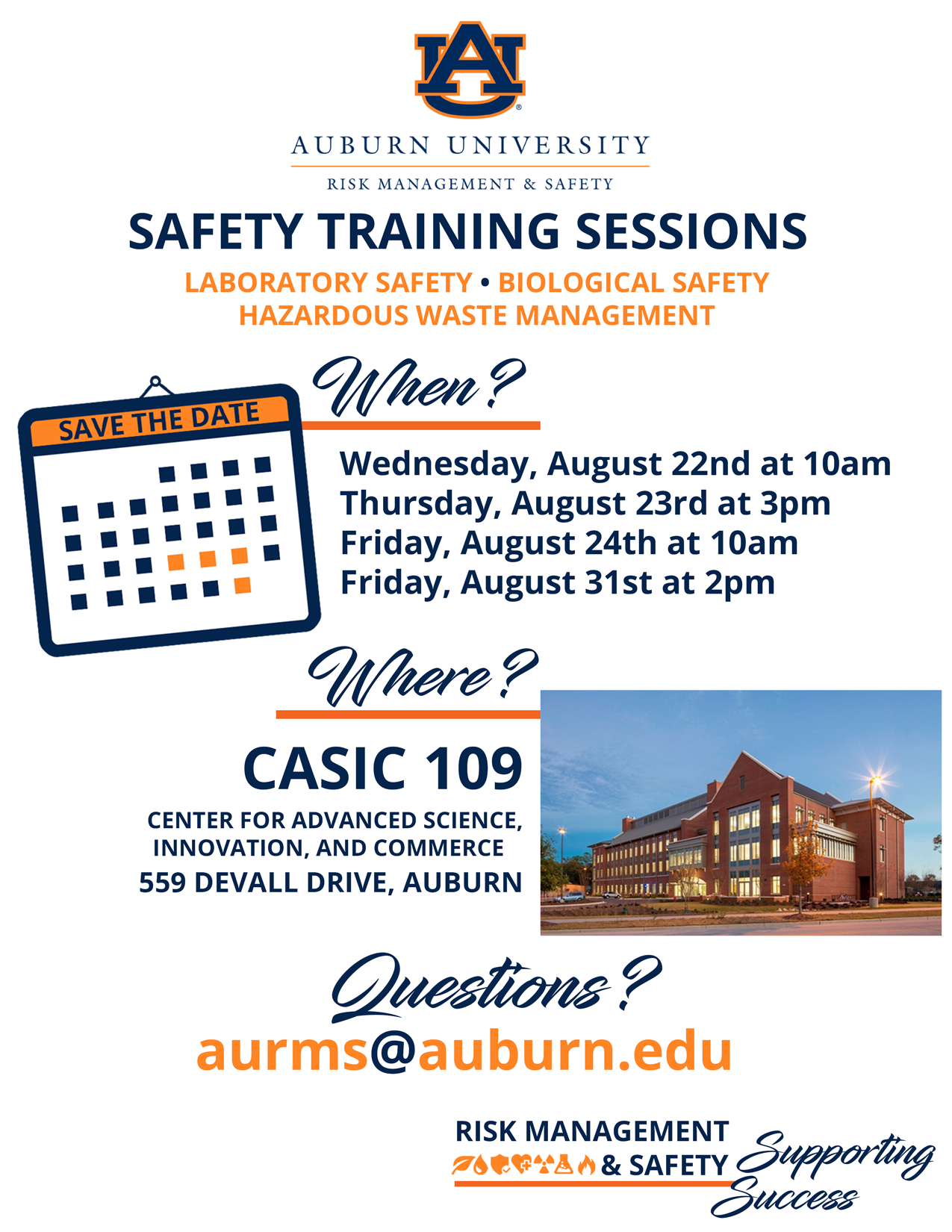
Young Water Ambassadors Experience Auburn and Conservation Firsthand
7/30/2018
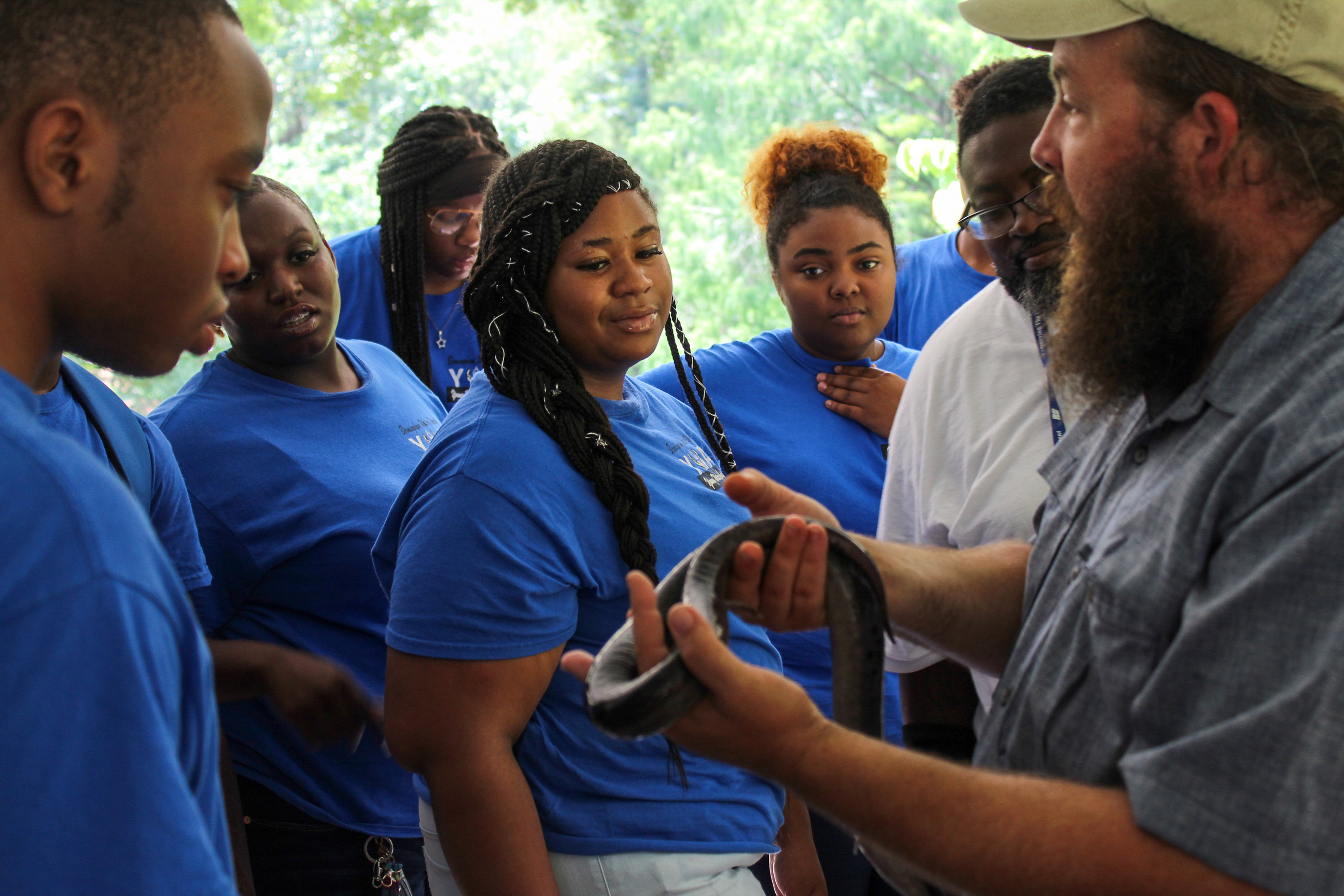
One hundred High School Juniors and Seniors from the Birmingham Area visited and toured the Donald E. Davis Arboretum on Wednesday, July 18, as part of Birmingham Water Works’ Young Water Ambassadors Program. This interactive tour was hosted, staffed, and was a collaborative effort from multiple research and conservation groups at Auburn University: the Donald E. Davis Arboretum, Auburn Risk Management and Safety, Alabama Cooperative Extension Services (ACES) Water Program, Auburn University Museum of Natural History, Auburn School of Forestry of Forestry and Wildlife Sciences, and the Auburn University Water Resources Center’s Alabama Water Watch Program.
“This annual partnership with the Birmingham YWA Program positively reflects Auburn University’s collaborative commitment to educate Alabama’s youth. Alabama is a water and ecologically rich state however with human populations, water pollution and climate variability on the increase these resources more than ever need to be protected,” said Tom McCauley, Environmental Program Manager for Auburn University Risk Management and Safety.
The Young Water Ambassadors (YWA) program consists of students who show an interest in science and environmental studies. The students participate in a six-week summer program that emphasizes the critical importance and preservation of water in Alabama. While at Auburn, the students broke into five groups to get interactive hands on demonstrations, thought-provoking discussions, and exceptional educational presentations. They learned how to monitor water, watershed stewardship, storm water management, sustainability, and unique biodiversity of Alabama’s water ways.
Mona Dominguez, Director of Alabama Water Watch, added “Inspiring young people to consider careers in water related fields directly relates to the AU Water Resource’s Center education and outreach goals. The Young Water Ambassadors Program does an excellent job of exposing students to a wide range of water related fields and thus makes for an excellent partner program for AUWRC. The annual YWA visit provides AU Staff with the opportunity to contribute positively not only to the future of the students, but also to the future of our state.”
Some highlights of the event included a tour of the Arboretum; hands-on activities illustrating the importance of soil quality, clean water, ecological research, and a presentation of some native species of amphibians, crustaceans, plant life, and reptiles for students to touch, interact, and view up-close.
All of these groups, while separate, united together to make this year’s event a success and help encourage these students and others to be positive ecology influencers in their community and help foster an understanding of conservation and preservation for all of Alabama’s natural beauty.
Human Resource Development Class details Auburn Univeristy's OJI Program
6/13/2018
On Wednesday, June 13, Auburn University Risk Management and Safety held a Human Resource Development course on the On-the-Job Injury Program (OJI).
Risk Management Specialists Holly Leverette and Brooke Patton gave real world scenarios and statistics showing how critical proper claim reporting is and the frequency, severity, and type of claims that have been handled by Auburn University.
The majority of the presentation went over how to report an OJI Claim and explained the program in more detail. This will allow for future claims to be handled promptly and properly and will benefit all Auburn University student, faculty, and staff.
Auburn University is exempt from State of Alabama’s Worker’s Compensation laws (25-5-50); however, Auburn’s OJI Program provides financial assistance to injured employees where no other benefits exist. The program is a benefit, not insurance, and provides benefits only after all other applicable insurance coverage has been exhausted. The program’s goal is to help protect employees from financial hardship caused from on-the-job injuries or illnesses. Risk Management and Safety is responsible for administration of the OJI Program.
More information on the OJI program can found at Risk Management and Safety’s website. There you will be able to view today’s presentation, get step by step instructions, and most importantly, file a claim.
For more information on today’s presentation or Auburn’s OJI program, please contact Auburn University Risk Management and Safety at 334-844-2502 or online at auburn.edu/rms.

Risk Management and Safety's Flapjack Forum Helps Educate, Advise, and Inform.
4/9/2018
Auburn University Risk Management and Safety held their quarterly Flapjack Forum on Thursday, April 5th at the School of Forestry and Wildlife Sciences. Guests were treated to free pancakes and a casual and relaxed atmosphere designed to improve communication of university risk across all units, departments, and colleges of Auburn University to better support the University’s mission. In a previous forum, data security was identified at a high impact and high likelihood risk for Auburn University. To help inform, educate, and begin a dialogue on data security; the Office of Information Technology presented recommendations to protect Personally Identifiable Information.
Personally Identifiable Information (PII) is currently defined by Auburn University as Social Security and Credit Card numbers. When PII is compromised through a data breach, it can lead to reputational damage, potential lawsuits and fines, and create a significant administrative burden. According to the 2017 Ponemon Institute Cost of Data Breach Study, the average total cost for a data breach in 2017 was $3.62 Million and the average size of a breach was 24,000 records.
OIT presented easy and hassle free ways to protect your PII on personal and university computers. These included recommendations to not store PII on external devices (such as thumb or flash drives), permanently deleting PII no longer needed (such as old budget files or hiring documents), and emptying the recycle bin of your computer regularly. One example of a recent PII scan by OIT discovered that 50% of the PII that was found resided on external drives. Although some units must handle PII on a regular basis, OIT recommended having secure business processes to help mitigate some of risk. OIT is here to help and aide any department to better protect their PII and determine where any weak points may reside and can be contacted at 334-844-4944. It is recommended that you reach out to OIT and find how to better protect yourself and your department.
Risk Management and Safety is committed to protect people, the environment, property, financial, and other resources in support of Auburn University’s teaching, research, outreach, and student services. The Flapjack Forum helps to accomplish this by understanding the needs and priorities of the university and developing materials and resources to provide guidance. For more information about how to attend the next Flapjack Forum and the mission of Auburn University Risk Management and Safety, please contact Kevin Ives at 334-844-2502 or email at pki0002@auburn.edu .
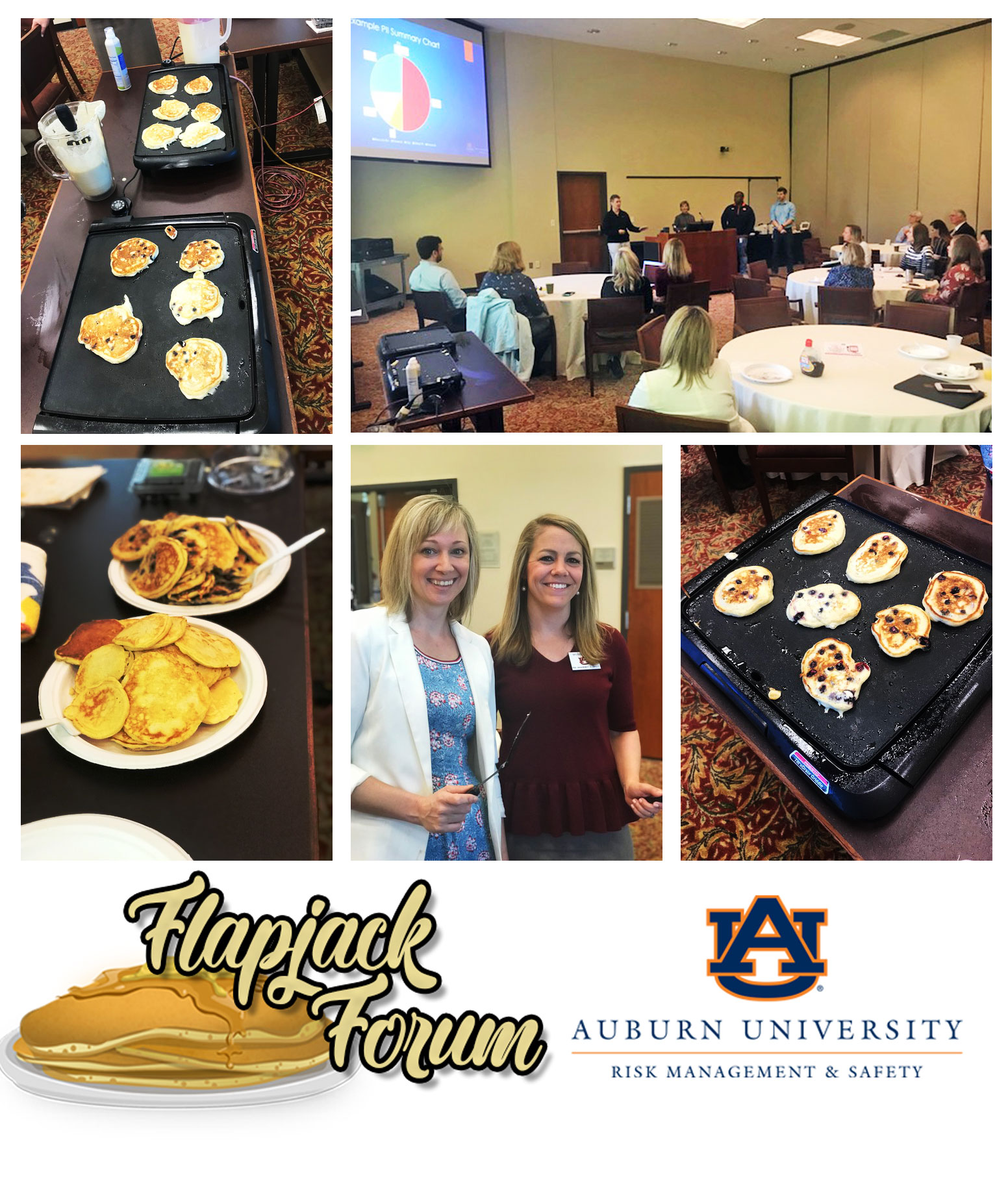
VCOM-Auburn Inaugural Disaster Drill Day invites emergency response preparedness collaboration between medical students, AU units and local agencies
6/30/2017
The scene was completely unexpected.
Dozens of second-year medical students in dark blue scrubs milled around the triage tents and tarps, many with looks of uncertainty on their faces, as disaster “victims” were brought into their areas. The “victims,” played by first-year medical students, all had pre-determined injuries and were in various stages of distress. Suddenly, recalling their training, the second-year medical students sprang into action, pulling from the medical skills many of them had cultivated thus far, mostly from a computer screen or classroom.
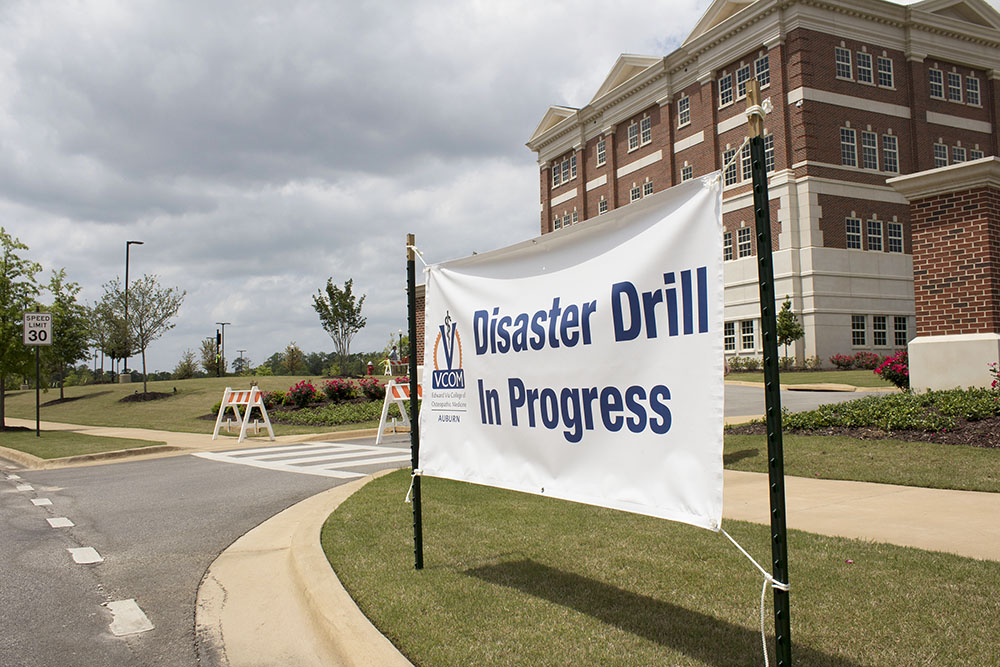 |
| The inaugural VCOM-Auburn Disaster Drill Day took place at the back of |
Such was the atmosphere on April 28 at the inaugural Disaster Drill Day, hosted by the Edward via College of Osteopathic Medicine-Auburn (VCOM) and in collaboration with Auburn University Risk Management & Safety (RMS). Other participants included first responders with the Auburn and Opelika Fire divisions, Auburn University Public Safety and members of the Campus Community Emergency Response Team (CCERT). Through two simulated disaster incidents – including a wreck with hazardous chemical spill and a tornado strike - more than 150 second-year VCOM medical students were evaluated on their emergency response abilities in order to obtain their National Basic Life Support certification.
The participants went into the drill blind, with no clue as to what the disasters would be or of the injuries they would have to know how to treat. The same can be said for real-life mass casualty situations, where every person affected – from local first responders and medical professionals, to universities and community members – must know how to respond in order to survive or save a life.
Though the original purpose of the Disaster Day Drill was to introduce medical students to the realities of a natural or man-made disaster as part of their learning, the overall resulting significance of the event was twofold…
Full-Scale Disaster Preparedness Scenarios Offer Life-Like Learning Environment
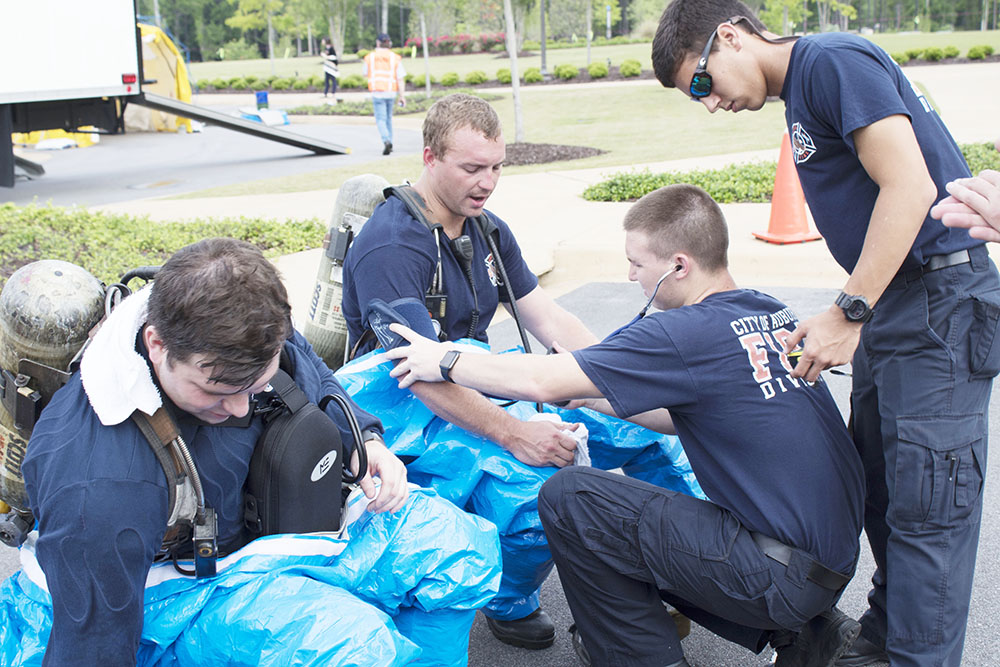 |
| Firefighters and first responders with Auburn & Opelika |
Tornados, fires, flooding, active shooters, bomb threats, hazardous chemical spills, civil disturbance… all these, and more, are risk vulnerabilities faced by today’s public/private universities and colleges.
Campus emergencies involving natural disasters and/or man-made crisis are not new developments in the academic environment, but in the last decade, disasters have affected university and college campuses with disturbing frequency, causing not only death and injury, but also monetary losses resulting from classroom disruption and damages to buildings/infrastructure.
The 2007 Virginia Tech massacre claimed the lives of 32 people. In 2009, students were evacuated from a Central Michigan University building following a chemical spill in a lab where one person was injured. Hurricane Irene caused damage and flooding to five east coast universities in 2011, while the April 27 tornado outbreak wreaked havoc on Alabama campuses just five months earlier. A murder/suicide resulted in nine deaths at an Oregon community college in 2015, and in mid-2017, two separate fires caused mass evacuations and damage at Boston University.
Though disasters themselves are common, colleges and universities that practice massive disaster preparedness scenarios involving students, faculty, staff and outside agencies have just become more prevalent. The State University of New York College at Oneonta (SUNY) has been conducting emergency simulations annually for several years, including simulated power failures, heat waves, and suicide and terrorist attacks. According to the Daily Star, SUNY partners with local police and fire agencies and other first responders “to create drills that are as life-like as possible to best prepare students, faculty and staff.”
Though Auburn University has held disaster drills on campus before, this was VCOM-Auburn’s first experience with disaster simulation and training as part of student curriculum. VCOM is a private, non-profit Osteopathic Medical School, with a campus located in Auburn University Research Park. The college has two other campuses – one in Virginia and one in South Carolina – where disaster simulations and training have been familiar annual events since the 2007 Virginia Tech shootings. Disaster simulations give medical students a closer look at how the environment inside a hospital could be impacted during a mass casualty situation and what type of skills would be expected of them.
 |
| VCOM-Auburn students in theater paint played "victims" of the first disaster scenario, a car crash and chemical spill. |
The first scenario of VCOM-Auburn’s Disaster Drill Day was a wreck involving university vans and a truck carrying hazardous chemicals, resulting in a hazardous chemical spill. Training alongside VCOM-Auburn students during this first scenario were more than 10 local first responders from Auburn and Opelika Fire divisions, and the East Alabama Medical Clinic EMS. Several of them suited up in HAZMAT gear to survey the scene of the accident, get the chemical spill under control and then venture through a life-like decontamination station.
Nearby, “casualties” of the wreck were delivered to the triage station where medical students began to assess their injuries before having them transported inside the school where three different simulated emergency rooms had been erected. Here, the real challenge for the students began. Assessing the wounded, they were tasked with performing various medical procedures on their patients to include delivering a baby from a “casualty” who went into labor (this was completed on a simulation dummy); properly sewing up a flesh wound; and/or inserting an IV, among others.
Second-year VCOM-Auburn medical student Clayton Lester said the hands-on experience of the drill was eye opening for him. During the first scenario, Lester had the opportunity to apply a suture to a wound and to insert a chest tube on a patient.
“I’ve done medical missions before where I learned how to set up a clinic,” said Lester, who was also a graduate of Auburn University. “But this type of learning, early on in my career, has given me a glimpse of what I might expect to see during a real disaster. It was chaotic, but beneficial training.”
VCOM-Auburn Associate Dean for Simulation and Technology Glenn Nordehn, DO, said there is no perfect drill. “However, this was a great training opportunity for the students to use their skills to improvise as well as problem solve the unexpected,” Nordehn added. “The expectation is for the students to learn how to act and how to manage in a disaster situation.”
Serving as the first joint disaster-training event involving VCOM, Auburn University and outside first responder’s organizations, much went into preparing the most useful and realistic disaster scenarios…
Where University & Local Agency Disaster Preparedness Intersect
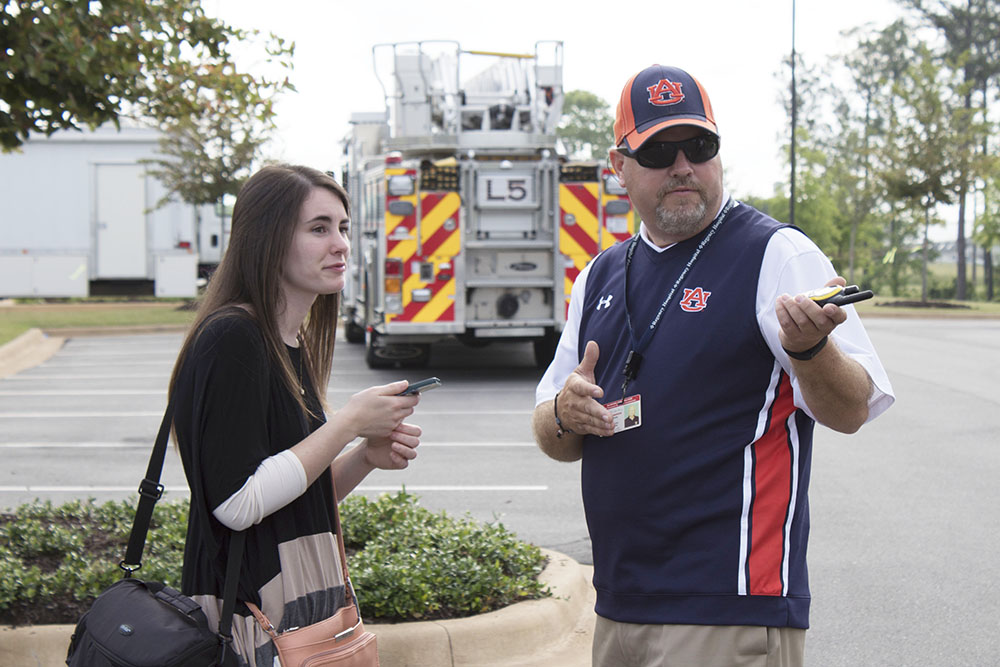 |
| RMS Mike Freeman, pictured with a reporter from the Opelika-Auburn News, was enlisted to plan the VCOM- Auburn disaster scenarios. |
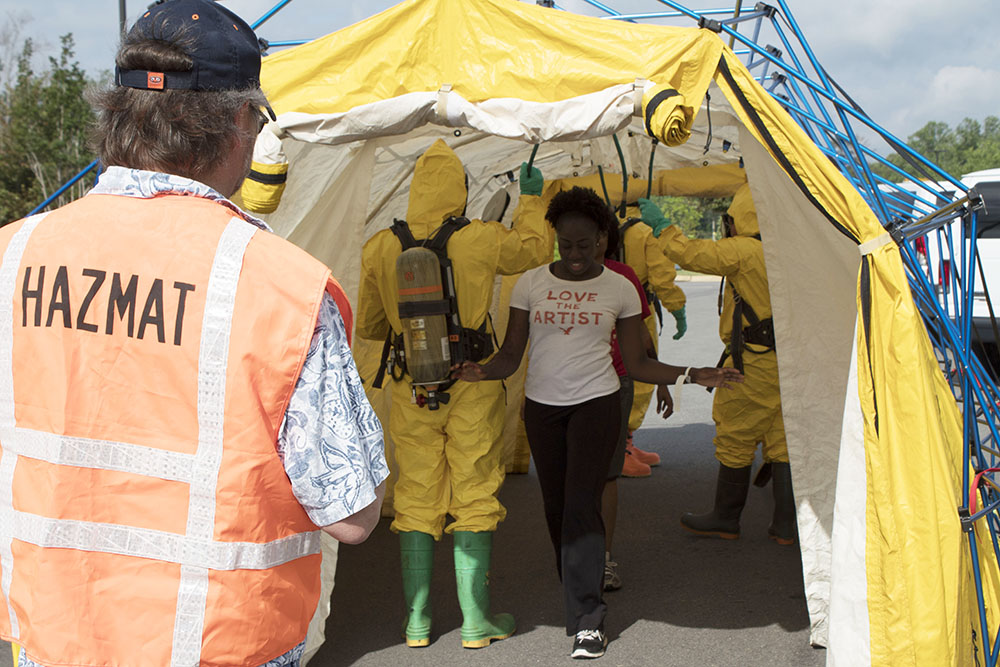 |
| Members of RMS HAZMAT suited up to run the |
Michael Freeman is a 28-year veteran of the environmental health and public safety industries, and has been employed with Auburn University’s RMS Department for more than 10 years. A former member of the U.S. Coast Guard and U.S. Army, Freeman has worked in fire, EMS and law enforcement. As a member of RMS, Freeman is a certified HAZMAT technician, responsible for HAZMAT management, spill response and transportation, among other things.
In January, VCOM contacted Freeman, who had experience conducting tabletop-type drills and had helped to train local responders on HAZMAT specifics, to ask for his help planning disaster scenarios for the Disaster Drill Day event.
“VCOM needed eight hours of instruction for the event,” Freeman said. “They also had certain components their students needed that I had to work into the scenarios. For example, they needed a HAZMAT component, traumas, a mass casualty situation, decontamination and EMS-type training.”
Around these components, Freeman also determined how best to utilize local first responders and university first responders, to maximize training for all. For example, during the chemical spill portion of the first scenario, other members of RMS trained in HAZMAT management, refreshed their skills by suiting up in personal protective equipment and helping casualties through the decontamination station, while local first responders trained in HAZMAT were responsible for utilizing their skills to contain the spill. In addition, members of Campus CERT - groups of trained individuals who have volunteered to take an active role during campus emergencies - got a refresher in search and rescue procedures as part of the tornado strike scenario later that day.
“This was the first large-scale disaster simulation to be held at VCOM-Auburn and in conjunction with local agencies,” Freeman said. “We could have done this without the local agencies, but it would not have been as realistic. If you do not practice real-life scenarios, you will not be prepared."
Deputy Chief of Auburn Fire Division Matt Jordan said first responders do not get the opportunity every day to train for HAZMAT situations. “It’s good to go through the motions like this, and we’ll go back to the station and talk about what we could have done differently,” Jordan said. “Training like this with the university is a benefit for everyone and is the type of infrastructure we want to set up. We like knowing what our resources are.”
With the Disaster Drill Day event, Jordan said local agencies get to combine their training with the knowledge from Auburn University’s subject matter experts to perfect disaster response.
While the various scenarios were playing out on the ground throughout the day, second-year VCOM-Auburn medical student Mike Brisson had quite a different view from above. A part-time paramedic with EAMC, Brisson not only brought along an ambulance to be used as a prop during the event, but also his personal Phantom III drone, which he used to take pictures of and survey the disaster drill scene from the air.
Brisson, also an Army captain and Black Hawk pilot, said his role of the day was to test how applicable drone footage could be, not only to first responders on a scene, but also to medical student training. Drones have become popular allies to first responders in the last few years, being used to more quickly and efficiently survey accident scenes to provide data.
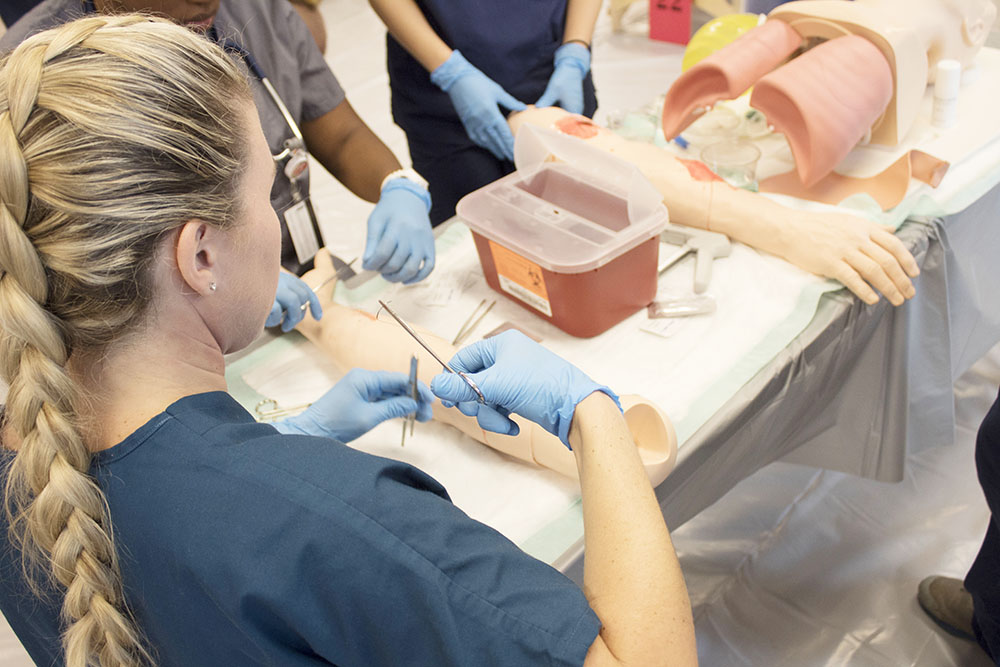 |
| Inside the makeshift hospital, second-year VCOM- |
“I can use this drone to get a better view of what type of hazardous materials have spilled,” Brisson said. “A drone can be sent in to survey a scene, like this chemical spill, ahead of first responders. I could see if the truck in the wreck was registered and determine what types of chemicals it was carrying. This type of information all allows first responders to safely prepare for and enter a scene without endangering their lives further.”
While Brisson’s drone provided invaluable footage for first responders to study, it was also broadcast on YouTube for other VCOM-Auburn students and administrators to watch as the events unfolded.
“It’s invaluable experience to offer these types of scenarios,” Brisson said. “From this vantage point, you get familiar with the entire picture of emergency care. To be able to integrate the medical school with community responders is invaluable training.”
Auburn University RMS is currently working on an official Drone Policy for the university as a result of increased drone usage on campus.
VCOM-Auburn marked Disaster Drill Day 2017 as a success and an important learning opportunity, and hopes to make it an annual event the school hosts going forward, possibly expanding involvement to the greater university community in years to come. To see footage of the April 28 event, click here.
Media Contact: Kati Burns, RMS Communications & Marketing | 334-844-2502 | klb0095@auburn.edu
Auburn Fire Department, university units to conduct special fire safety training at Jordan-Hare
6/29/2017
The Auburn Fire Department will conduct a training exercise at Jordan-Hare Stadium this summer that will have long-term benefits for not only local firefighters, first responders and the university community as a whole, but future game-day fans as well.
On Thursday, June 8, between 10 and 15 Auburn firefighters will hook up firehoses to pressurized pipes at different connection points around the stadium to conduct firefighting scenarios. The training will take place from 8 a.m. to noon, and several sidewalks around the stadium will be closed during this time, due to water that will be released from the hoses. The sidewalks on the east side of the stadium near the Tiger Transit bus stops and the Student Center will be closed, as well as the sidewalks on the west side of the stadium on Donahue Drive. Ongoing summer construction projects around the stadium will also be a factor, so anyone entering the area during this time is required to follow proper safety precautions by wearing appropriate Personal Protective Equipment (PPE) such as a hard hat, safety glasses and steel-toed or sturdy shoes.
The firefighter-training event was scheduled in conjunction with testing of the stadium’s sprinkler system, to be performed by university contractor Brendle Sprinkler Company. According to the Auburn University Risk Management & Safety Department’s (RMS) Safety & Health Programs Manager Chris Carmello, the university is required by the National Fire Protection Association to test dry sprinkler systems every five years.
“It was time for us to test the system at Jordan-Hare, and the fire department had already asked if they could come get some training at the stadium if we ever charged the pipes with water,” Carmello said. “This is not a safety issue; that’s not why we’re doing this. This is simply a once-in-every-five-years opportunity for the fire department to get some hands-on experience on-site, at an outdoor location where they’ll actually be able to use high-pressure water hoses while training.”
According to Carmello, there are important differences between a “wet sprinkler system” and a “dry sprinkler system” that made this training at the stadium more attractive to the fire department. Wet sprinkler systems always have water in the pipes, but dry sprinkler systems, such as those at the stadium, do not, which means there will be a bit of a lag in the time it takes the water to spread throughout the pipes when charged.
“This training will give the fire department a better idea of how quickly the water can get to where it needs to be in the event of an emergency at the stadium,” Carmello said.
In addition, unique factors during the training will present some challenges to the firefighters. For example, there are three connection points around the stadium that will be utilized for training – one on the east side of the stadium and two on the west side. The connection on the east side requires a different type of connection, so the firefighters will be challenged to run a different type of hose.
Carmello said this entire scenario would be a troubleshooting opportunity for everyone involved. “The fire department will get to troubleshoot what kind of issues they might be presented with during the event of a real emergency at a very high profile facility. Our contractor, Brendle, will be able to look for leaks or any weaknesses in the pipes, and, based off these results, RMS will be that much more prepared and able to address issues that could arise during game days. This entire effort ensures the safety of our game days and our game day fans.”
Several university departments and units worked with the fire department to make this training possible, including Risk Management & Safety, Auburn University Athletics, Facilities Management and Auburn University Public Safety.
Media Contact: Kati Burns, RMS Communications & Marketing | 334-844-2502 | klb0095@auburn.edu
Special Firefighter Training Day at Jordan-Hare: Auburn Fire commends RMS for help making game days safer for fans
6/29/2017
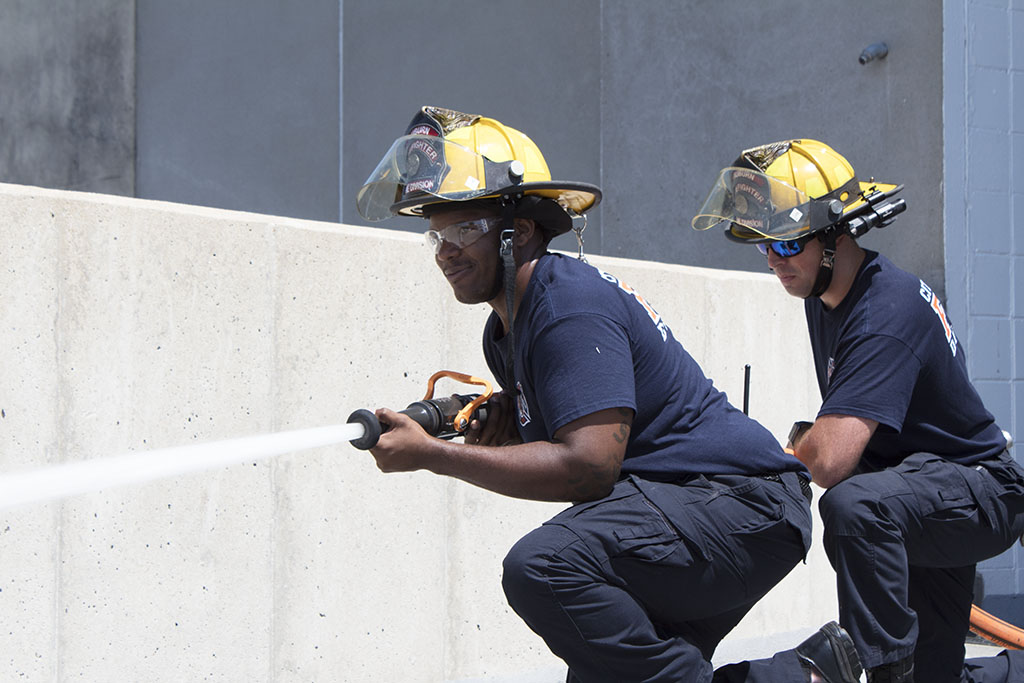 Despite recent days of dark clouds and heavy rainfall, firefighters with Auburn Fire Division were thankfully met with sunny blue skies for their training at Jordan-Hare Stadium on June 8. It had been a busy night and morning for Auburn firefighters, with more emergency calls than usual, but close to 10 firefighters were on hand for the special fire safety training the division had desired to do for more than a year.
Despite recent days of dark clouds and heavy rainfall, firefighters with Auburn Fire Division were thankfully met with sunny blue skies for their training at Jordan-Hare Stadium on June 8. It had been a busy night and morning for Auburn firefighters, with more emergency calls than usual, but close to 10 firefighters were on hand for the special fire safety training the division had desired to do for more than a year.
The fire department partnered with Auburn University Risk Management & Safety (RMS) to receive important training on the stadium’s wet and dry fire protection systems, while university contractor Brendle Sprinkler Company and RMS tested the sprinklers at the same time. This testing of the stadium’s dry water fire protection systems happens every five years, a requirement of the National Fire Protection Association.
“This was a once-in-every-five-years opportunity for the fire department to get some hands-on experience on-site, at an outdoor location where they would actually be able to use high-pressure water hoses while training,” said Chris Carmello, RMS Safety & Health Programs manager. “There are important differences between a “wet sprinkler system” and a “dry sprinkler system” that made this training at the stadium more attractive to the fire department.”
Wet sprinkler systems always have water in the pipes, but dry sprinkler systems, such as some of the standpipe systems at the stadium, do not, which means there will be a bit of a lag in the time it takes the water to spread throughout the pipes when charged. There are five fire hydrants around the stadium and two standpipe systems inside the stadium.
The training began on the ground level of the stadium with firefighters and staff with Brendle testing the pressure of the water and releasing any old water standing in the pipes. Firefighters then carried hoses up five flights of stairs to the very top of the stadium where they hooked up to the stadium’s standpipe system and waited for the hose to fill with water.
“It’s invaluable that we have this kind of training where some 80,000 fans could be gathered,” said Jeff Nolin, Auburn Fire Division battalion chief. “We need this kind of muscle memory and the experience of stretching the hoses in a building that we’re actually going to be working in.”
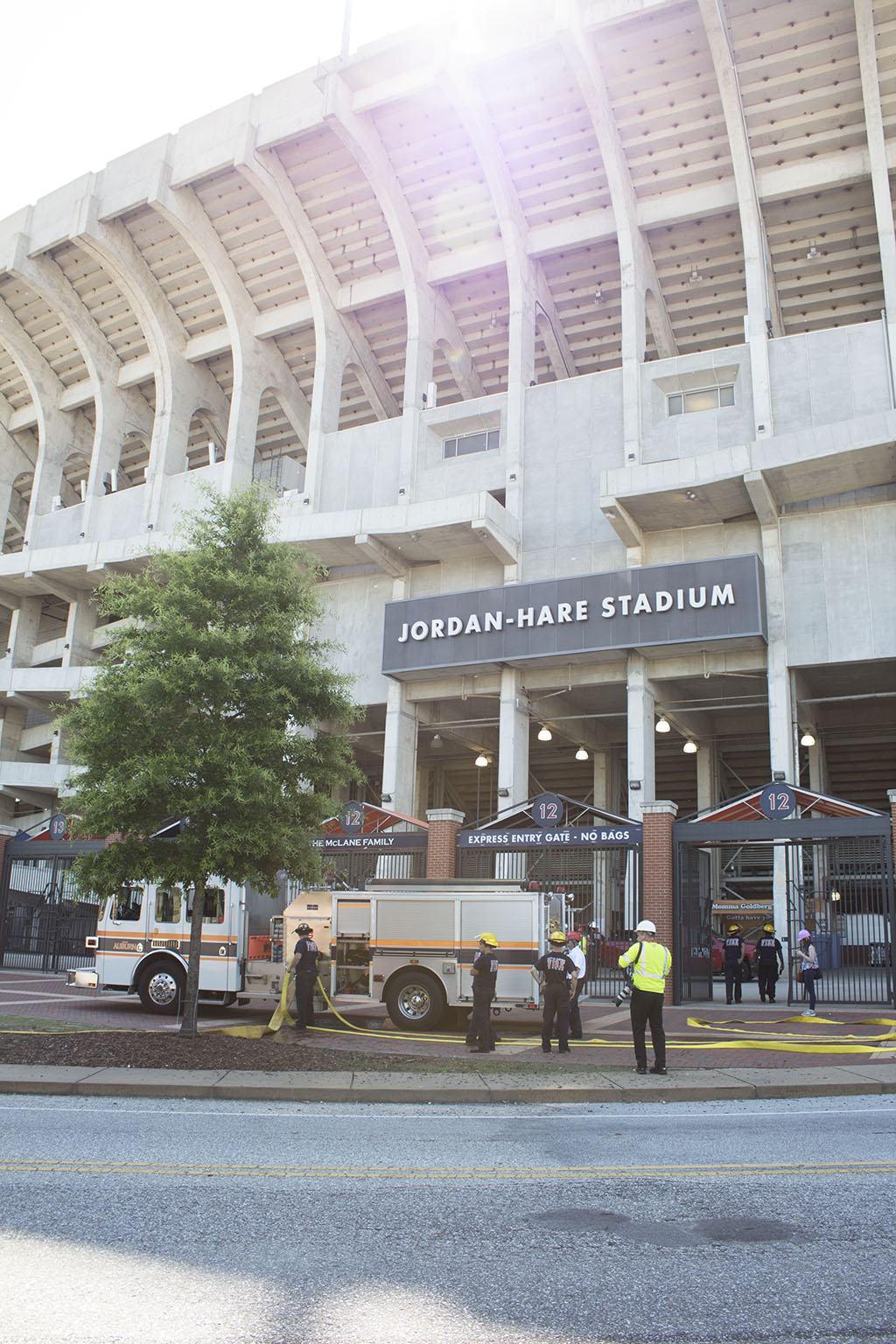 The training lasted from 8 a.m. until about noon. The testing allowed both firefighters, RMS and Brendle to find any leaks, breakages or other defects throughout the system.
The training lasted from 8 a.m. until about noon. The testing allowed both firefighters, RMS and Brendle to find any leaks, breakages or other defects throughout the system.
“These scenarios help us to think about logistics ahead of time, like where we need to have personnel during game days and any situations they might run into trying to get to the fire,” said Deputy Fire Chief Matt Jordan. “If there is a fire, we’re going to have to evacuate people, move people around also.”
The stadium training was the first opportunity the Auburn Fire Division has had to use the “high-rise packs” purchased specifically for the stadium almost two years ago. The division typically has firefighters staged at the stadium during game days, with additional personnel to call-in if need be.
“This time of year, we’re thinking about football season, putting our people in place and just preparing for any new developments – like new constructions that may have gone up that could affect our response times or typical staging areas,” Jordan said.
“It’s our job to prepare for “worst case scenarios.” The university has done a great job making this a safe environment for the university community and the fans. RMS does a great job collaborating with us, inspecting fire extinguishers ahead of time, and managing contractors and vendors. We are always very impressed with their help.”
Media Contact: Kati Burns, RMS Communications & Marketing | 334-844-2502 | klb0095@auburn.edu


